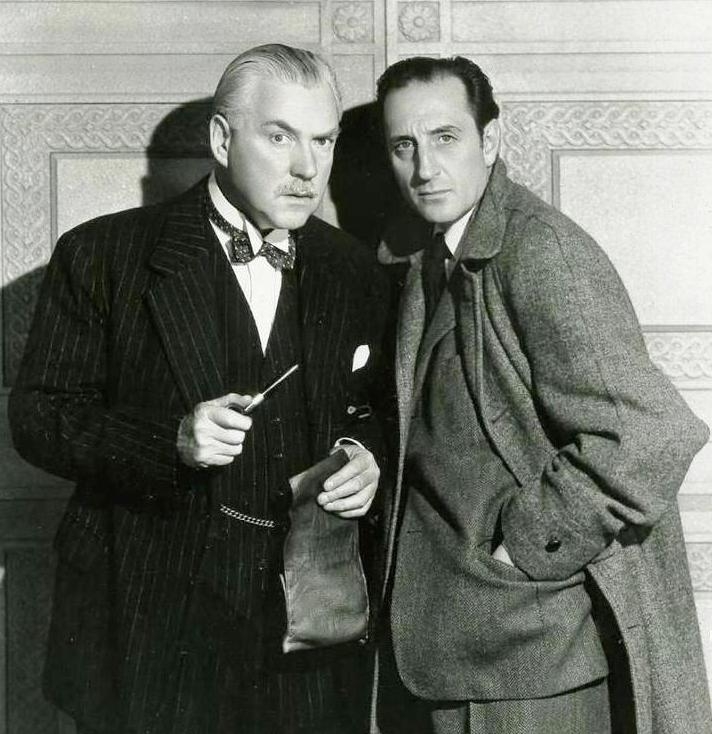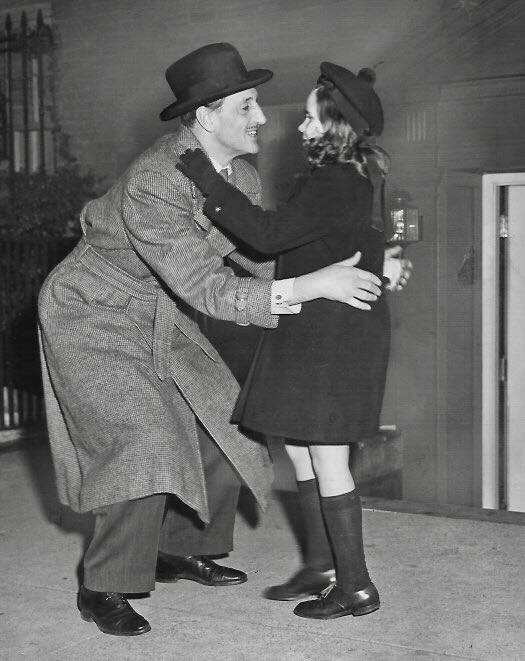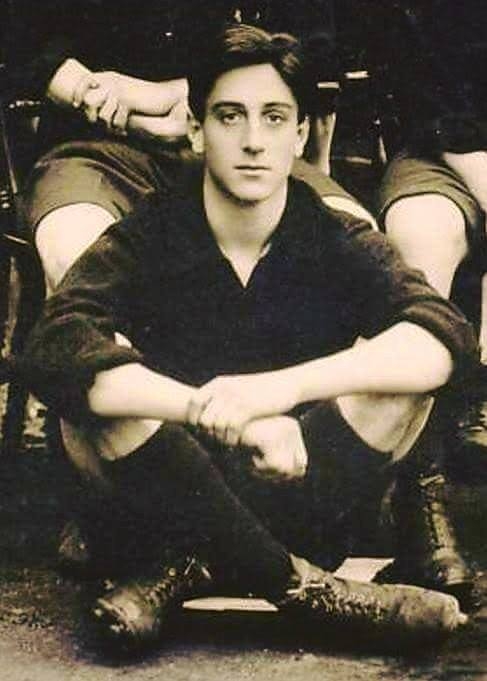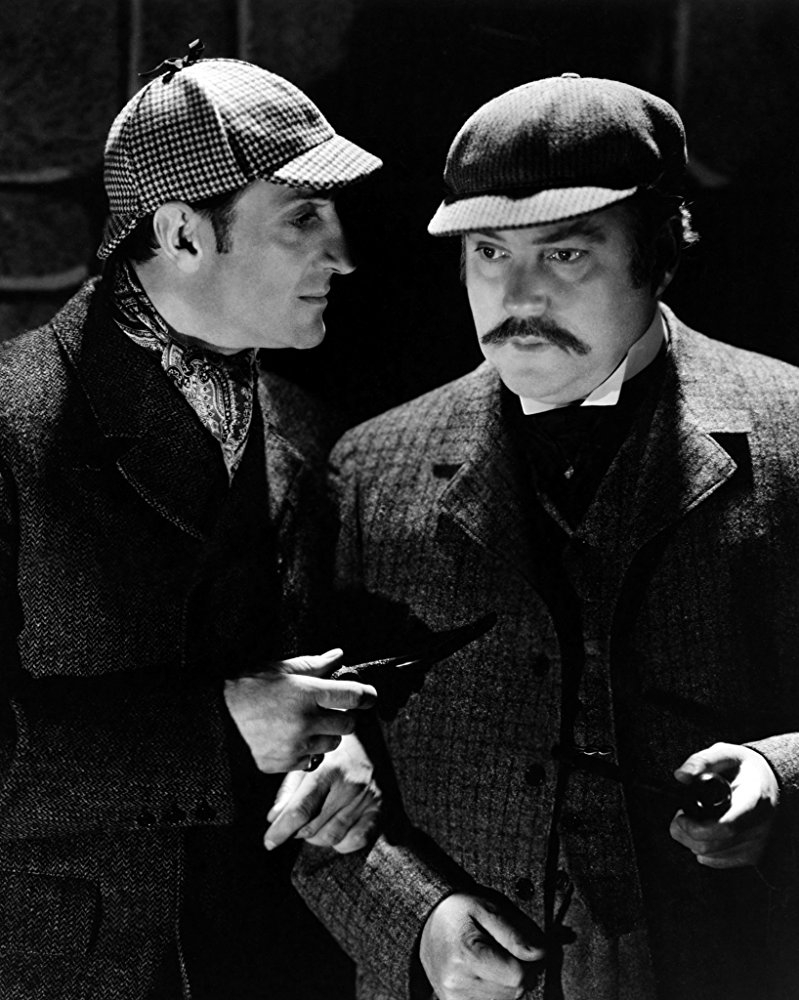Born June 13, 1892 in Johannesburg, South Africa
Died July 21, 1967 in New York City, New York, USA (heart attack)
Birth Name Philip St. John Basil Rathbone
Nickname Ratters
Height 6' 1½" (1.87 m)
Basil Rathbone was born in Johannesburg, South Africa, in 1892, but three years later his family was forced to flee the country because his father was accused by the Boers of being a British spy at a time when Dutch-British conflicts were leading to the Boer War. The Rathbones escaped to England, where Basil and his two younger siblings, Beatrice and John, were raised. Their mother, Anna Barbara (George), was a violinist, who was born in Grahamstown, South Africa, of British parents, and their father, Edgar Philip Rathbone, was a mining engineer born in Liverpool.
Rathbone was hired as an actor on the condition that he work his way through the ranks, which he did quite rapidly. Starting in bit parts in 1911, he was playing juvenile leads within two years.
For the remainder of the decade Rathbone alternated between the London and New York stages and occasional appearances in films. In 1929 he co-wrote and starred as the title character in a short-running Broadway play called "Judas". Soon afterwards he abandoned his first love, the theater, for a film career. During the 1920s his roles had evolved from the romantic lead to the suave lady-killer to the sinister villain (usually wielding a sword), and Hollywood put him to good use during the 1930s in numerous costume romps, including Captain Blood (1935), David Copperfield (1935), A Tale of Two Cities (1935), Anna Karenina (1935), The Last Days of Pompeii (1935), The Adventures of Robin Hood (1938), Tower of London (1939), The Mark of Zorro (1940) and others. Rathbone earned two Oscar nominations for Best Supporting Actor as Tybalt in Romeo and Juliet (1936) and as King Louis XI in If I Were King (1938).
However, it was in 1939 that Rathbone played his best-known and most popular character, Sherlock Holmes, with Nigel Bruce as Dr. Watson, first in The Hound of the Baskervilles (1939) and then in The Adventures of Sherlock Holmes (1939), which were followed by 12 more films and numerous radio broadcasts over the next seven years.
Feeling that his identification with the character was killing his film career, Rathbone went back to New York and the stage in 1946. The next year he won a Tony Award for his portrayal of Dr. Sloper in the Broadway play "The Heiress," but afterwards found little rewarding stage work. Nevertheless, during the last two decades of his life, Rathbone was a very busy actor, appearing on numerous television shows, primarily drama, variety and game shows; in occasional films, such as Casanova's Big Night (1954), The Court Jester (1955), Tales of Terror (1962) and The Comedy of Terrors (1963); and in his own one-man show, "An Evening with Basil Rathbone", with which he toured the U.S.
Spouse (2)
Ouida Bergère (18 April 1926 - 21 July 1967) (his death) (1 child)
Ethel Marion Foreman (13 October 1914 - 1926) (divorced) (1 child)
Trade Mark (6)
Best known for playing suave villains in period swashbuckler films, such as The Adventures of Robin Hood (1938) and Captain Blood (1935).
Had one son with Ethel Marion Foreman: John Rodion.
Had one daughter with Ouida Bergère: Cynthia Rathbone (1939-1969).
Nominated for a Best Supporting Actor Oscar twice, and lost both times to the very same actor, Walter Brennan.
Had portrayed the title character on Blue (1939-1942) and Mutual (1943-1946) Radio's "The New Adventures of Sherlock Holmes".
Following his death, he was interred at Ferncliff Cemetery in Hartsdale, New York.
Won Broadway's 1948 Tony Award as Best Actor (Dramatic) for his performance as Dr. Sloper in the original Broadway production of "The Heiress". The award was shared with Henry Fonda for "Mister Roberts" and Paul Kelly for "Command Decision".
Was so frequently typecast as a villain that he literally jumped at the first few opportunities he ever got to play Sherlock Holmes because "for once, I got to beat the bad guy instead of play him". Indeed, he played the legendary heroic detective more than any other character in his career. However, by 1946, he had become so sick of the role that he quit his Sherlock Holmes film series and temporarily returned to the Broadway stage. Over the course of his career, he had played the super sleuth in 16 films and over 200 radio plays.
Although he has been immortalized as a screen villain, before he played Murdstone in 1935, he had never played a villain and he was known, both on film and stage, exclusively as a matinée idol and romantic leading man.
Fought in the British Army during World War I, and was awarded the Military Cross for bravery under fire.
He is considered the greatest swordsman in Hollywood history, superior even to on-screen foes Errol Flynn and Tyrone Power. However, because he was so frequently cast as the villain, he won only two on-screen duels in his career - as Tybalt in Romeo and Juliet (1936), for which he earned an Oscar nomination, and as Captain Esteban Pascuale against the friar (Eugene Pallette), who was so outclassed by "the Capitan" he was harmlessly disarmed in a matter of seconds, in The Mark of Zorro (1940). His last, filmed when the actor was 63, was with Danny Kaye in The Court Jester (1955). It is considered by some the best sword fight ever filmed.
He was awarded 3 Stars on the Hollywood Walk of Fame: for Motion Pictures at 6549 Hollywood Boulevard; for Radio at 6300 Hollywood Boulevard; and for Television at 6915 Hollywood Boulevard in Hollywood, California.
He never renounced his British citizenship and was a lifelong member of the Conservative party.
Was related by marriage to the famous Huxley family. His wife's niece, Ouida Branch, whom they brought up from an early age, married David Bruce Huxley, the brother of famed writers Aldous Huxley and Julian Huxley and Nobel Prize-winning scientist Andrew Huxley.
British Army Fencing Champion.
The Sherlock Holmes-esque Basil of Baker Street in The Great Mouse Detective (1986) is named after Rathbone who was perhaps best known for the many times he played Sherlock Holmes.
Distant relative of Julian Rathbone.
Rathbone was a firm believer in ESP. When he was four, his parents booked passage on a ship taking them from South Africa to Britain. His mother had a dream that the ship would sink in the bay of Biscay and convinced her husband that they she take a later boat. She was proved prescient when the ship did sink with a loss of all hands.
He was the favorite choice of Gone with the Wind (1939) author Margaret Mitchell to play the role of Rhett Butler.
The Rathbones were a Hollywood exception in that they remained a happily married couple for more than four decades. During their heyday in Hollywood, they were known to host the most lavish epicurean parties. For many years, they (and their six dogs) lived in a house in the Los Feliz Hills, overlooking Hollywood, which had once been owned by the prizefighter Jack Dempsey and his wife, the actress Estelle Taylor.
ADVERTISEMENT
BY
Looking for more information?

 Amanda S. Stevenson
Amanda S. Stevenson 
 Amanda S. Stevenson
Amanda S. Stevenson  AncientFaces
AncientFaces 
 Amanda S. Stevenson
Amanda S. Stevenson 
 Amanda S. Stevenson
Amanda S. Stevenson 
 Amanda S. Stevenson
Amanda S. Stevenson 
 Amanda S. Stevenson
Amanda S. Stevenson 
 Amanda S. Stevenson
Amanda S. Stevenson 
 Amanda S. Stevenson
Amanda S. Stevenson 
 Amanda S. Stevenson
Amanda S. Stevenson 
 Amanda S. Stevenson
Amanda S. Stevenson 